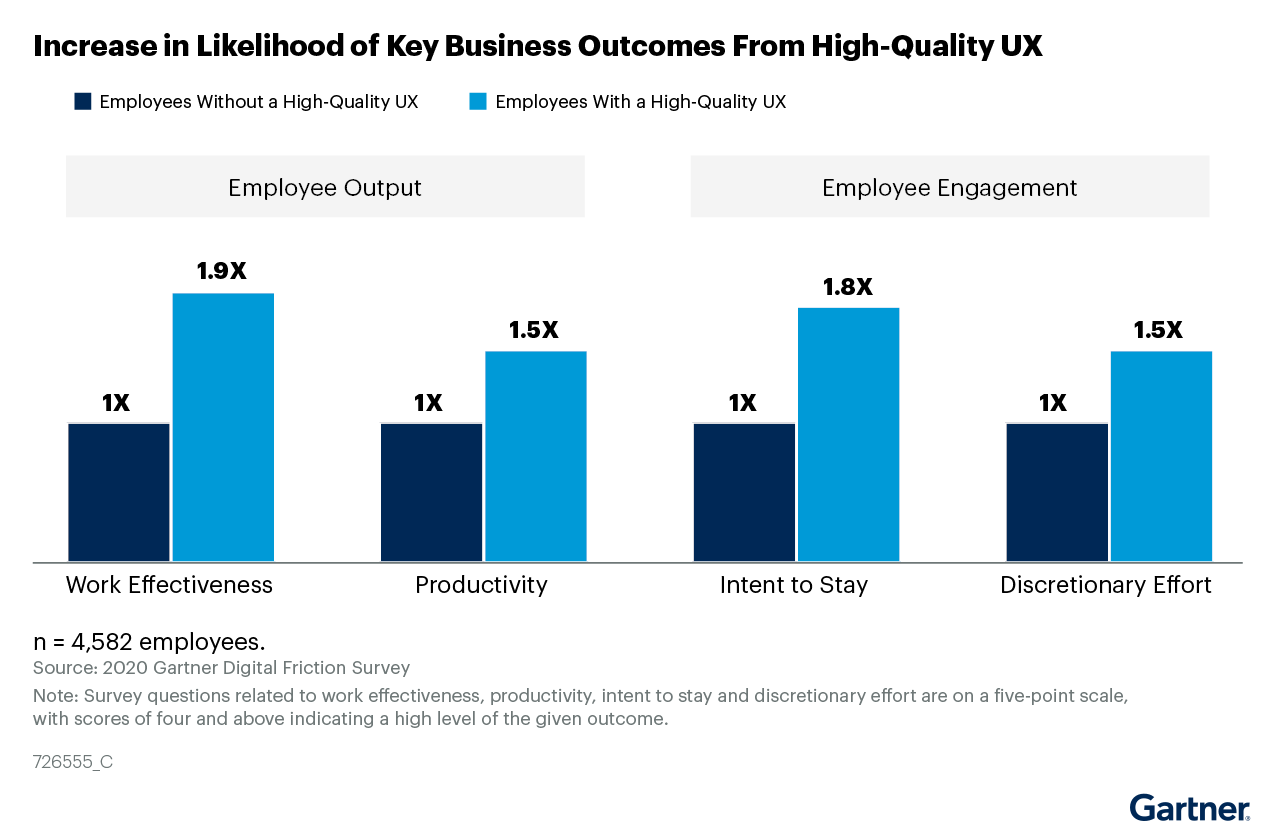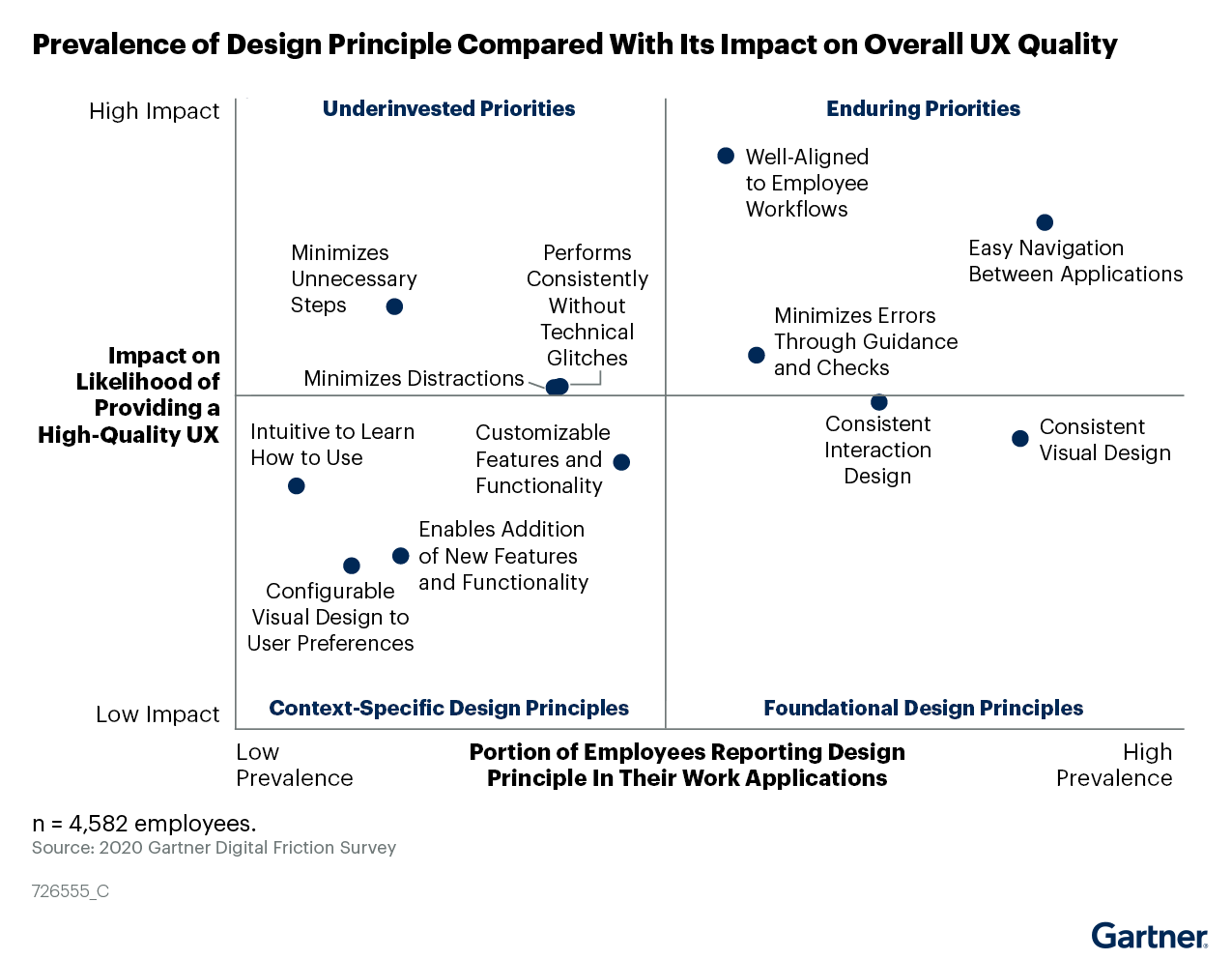Typically, the discussion surrounding user experience (UX) tends to focus predominantly on customers. However, the recent transition to remote work during the pandemic demonstrated the increasing importance of high-quality UX in enabling employee success. Many organizations invest significant resources in implementing advanced analytics solutions, yet still fail to gain any valuable insights or observe any returns in productivity due to poor employee engagement.
Gartner®, Inc, which delivers actionable, objective insight to executives and their teams, “examines the impact of employee UX on key business outcomes and identifies employee-centric practices for software engineering leaders to deliver a high-value employee UX. As we move forward from the pandemic and organizations look to make the most of their data, it’s critical that IT managers prioritize the user experience of their employees.
(All citations contained in this article are sourced directly from: Gartner, Inc.,“Proven Design Principles to Deliver a High-Value Employee User Experience”, Applications and Software Engineering Research Team, 12 May 2020. GARTNER is a registered trademark and service mark of Gartner, Inc. and/or its affiliates in the U.S. and internationally and is used herein with permission)
High quality UX is strongly correlated with productivity and work effectiveness
In many organizations, good UX is often considered a luxury or supplemental feature when compared to other analytics objectives like cost and function. This can often be attributed to a lack of support and understanding from upper-level leadership regarding the role that UX plays in facilitating output and operational efficiency.
In its recent study, Gartner found that “a high-quality employee UX has the greatest impact on employee work effectiveness, increasing the likelihood an employee will have high work effectiveness by 1.9 times.” Gartner further states, “Employees with a high-quality UX are also 1.5 times more likely to have high levels of productivity as indicated by high output per hour worked.
The encompassing aspect that UX plays across all employee functions should make it a priority for any IT department. Making the most of an organization’s analytics entails investing in the design principles and methodologies that best enable employee success.
 (pg. 5)
(pg. 5)
Incorporating employee feedback and expanding application freedom can enhance UX quality
One of the best ways to find how to best enable employee success with analytics is to simply incorporate them in the design process. Employee-centered design means that employees need to be able to provide feedback and voice their needs in developing operational systems. This can take many forms from employing surveys and interview panels to providing departments with more flexibility in choosing their own tools and solutions.
Gartner found that, “employees who are given the opportunity to provide feedback on ways to improve the design and usability of existing applications and on new applications before they are deployed are at least 3.9 times more likely to have a high-quality UX.” Acquiring actionable user input can be achieved through a variety of methods that include built in feedback measures, user satisfaction surveys, and holding focus groups. For upcoming applications, employees can also be invited to test prototypes and try new vendor solutions.
Furthermore, Gartner also found that, “employees with greater choice and flexibility are at least 2.1 times more likely to have a high-quality UX.” Measures like governance frameworks and approved technology lists allow organizations to increase employee freedom while also mitigating the possibility of unnecessary costs, technology compatibility issues, and security risks.
Labor-saving solutions that align with workflows are the best method for attaining high-quality employee UX
There are many principles that software teams can apply in designing analytics solutions for employee use. Overall, employees benefit most from implementations that reduce labor and streamline how employees navigate from one task to the next. Not only does this improve overall employee efficiency (and in turn, that of the business), but it also promotes employee engagement and satisfaction.
In its report, Gartner identified some of the best practices for attaining high-quality employee UX. According to Gartner, “Design principles that are both highly prevalent and have a large impact on UX quality are priorities that organizations should continue to emphasize. These include ease of navigation between applications, alignment with workflows, and guidance and checks to minimize errors.
Considered to be both highly prevalent and having a large impact on employee UX, these features should continue to be emphasized by software engineers and IT departments.
By prioritizing certain design features over others in promoting employee UX, organizations are better able to make the most of their analytics resources and see a greater return on investment. The key to successful UX design is establishing clear-cut objectives and well-defined pathways for achieving them.
 (pg. 9)
(pg. 9)
High-quality UX can no longer be viewed as optional
As the world continues to advance and people increasingly rely on the power of analytics in their decision making, organizations must advocate for and prioritize high-quality UX for their employees. Better UX leads to increased productivity and reduced resource waste, ensuring that organizations are making the most of their data.
- How Spirits Brands Can Improve Brand Loyalty with Data Analytics - January 30, 2024
- The Collapse of Herbl, and How Other Cannabis Distributors Can Avoid the Same Fate - January 24, 2024
- Top 5 Blog Posts of 2023 - December 28, 2023



